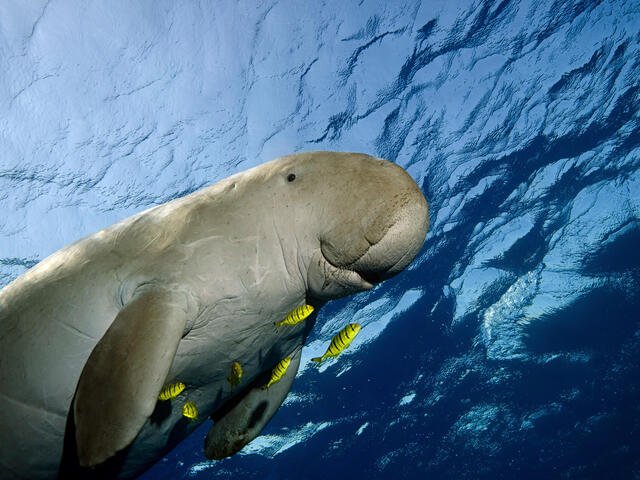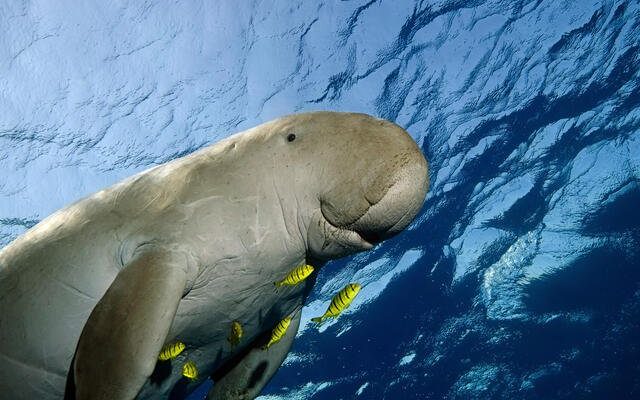
Dugongs are not just another marine animal; they play a vital role in maintaining the health of seagrass ecosystems. Think of them as underwater gardeners. By grazing on seagrass, they help keep it growing and thriving, which provides habitat for many other marine species. But, like a flower struggling in a polluted garden, dugongs are threatened by various human activities and environmental changes. Here’s the thing: the more we understand about their plight, the better we can advocate for their conservation.
What is the Dugong?
Dugongs belong to the order Sirenia, which also includes manatees. These gentle giants can grow up to 10 feet long and weigh between 500 to 1,100 pounds. They have a distinctively elongated body with a rounded snout, perfect for rooting through seagrass beds. Dugongs are unique in that they are the only marine mammals that exclusively feed on seagrass. Their diet consists mainly of halophila and posidonia, two types of seagrass, which are crucial for the marine ecosystem.
One of the most fascinating things about dugongs is their social behavior. They are often found in small groups, usually made up of mothers and their calves. Dugong calves stay with their mothers for about two to three years, learning essential survival skills. Imagine a mother teaching her child to forage for food in an underwater garden—it’s a heartwarming picture, isn’t it?
But as enchanting as they are, dugongs face serious challenges. Populations have dwindled in many areas due to human activities, which we’ll explore further.
Why are Dugongs Endangered?
The dugong population is under pressure from several threats. The most significant issues include habitat loss, hunting, and climate change. Here’s a closer look at each threat and how it impacts dugongs.
Habitat Loss: One of the main reasons dugongs are endangered is the loss of seagrass habitats. Coastal development, such as building resorts or marinas, often leads to the destruction of these vital seagrass beds. Additionally, pollution and agricultural runoff can cause algal blooms, which can smother seagrass. As their food source dwindles, dugongs have a harder time surviving.
Hunting: Dugongs have traditionally been hunted for their meat and oil. In some cultures, they are considered a delicacy. Even though there are laws protecting them in many countries, illegal hunting still occurs, putting additional pressure on dwindling populations. It’s a sad reality that these beautiful animals are still targeted for food, despite the conservation efforts.
Climate Change: Climate change is like a double-edged sword for dugongs. Rising sea levels can further destroy their seagrass habitats, while warmer water temperatures can also lead to a decrease in seagrass health. The changing climate disrupts the delicate balance of the marine ecosystem, affecting not just dugongs but countless other species as well.
Current Global Conservation Efforts
Several organizations and governments are working hard to protect dugongs and their habitats. You might be wondering, “What’s being done to help these gentle giants?” Here are some key conservation strategies currently in place.
Protected Areas: Many countries have designated marine protected areas (MPAs) where dugongs are safe from hunting and habitat destruction. These areas are crucial for allowing seagrass habitats to thrive without human interference. For example, Australia has several MPAs that focus on dugong protection, providing a sanctuary where these animals can flourish.
Public Awareness Campaigns: Raising awareness is essential for conservation. Programs that educate local communities about the importance of dugongs and their ecosystems have been implemented in various regions. When people understand the role dugongs play in the environment, they’re more likely to support conservation efforts. It’s amazing how one small shift in perspective can lead to big changes!
Research and Monitoring: Scientists are continuously studying dugongs to better understand their behavior, habitat needs, and population dynamics. Monitoring tools like satellite tracking help researchers keep tabs on dugong movements and assess the effectiveness of conservation efforts. The more we learn, the better equipped we are to protect these creatures.
The Role of Local Communities in Conservation
Local communities are critical to the success of dugong conservation. After all, they often live in close proximity to dugong habitats and can play a huge role in protecting these animals. Here’s how they’re making an impact.
Sustainable Practices: Many communities are adopting more sustainable fishing and farming practices to minimize the impact on seagrass habitats. By promoting responsible fishing techniques, these local communities help ensure that dugongs have access to their food sources.
Community-Led Initiatives: Local groups often spearhead conservation projects, working alongside NGOs and government agencies. These initiatives can include beach clean-ups, habitat restoration, and even monitoring dugong populations. When the community is invested in the well-being of their local wildlife, it creates a powerful force for change.
Cultural Significance: For some indigenous communities, dugongs hold deep cultural significance. By incorporating traditional ecological knowledge into conservation efforts, these communities can create solutions that respect their heritage while promoting biodiversity. It’s a beautiful blend of culture and conservation.
What You Can Do to Help Dugongs
Feeling inspired to make a difference? Here are some simple ways you can help dugongs and support their conservation.
Support Marine Conservation Organizations: Donating to or volunteering with organizations that focus on marine conservation can make a real impact. Your contributions help fund critical research, habitat restoration, and public awareness campaigns.
Be a Responsible Traveler: If you visit areas where dugongs live, practice responsible tourism. This means respecting local wildlife, not engaging in any activities that threaten their habitats, and participating in eco-friendly tours.
Spread the Word: Share what you’ve learned about dugongs with friends and family. The more people know about these creatures and their struggles, the more support they’ll gather for conservation efforts. It’s all about building a community of advocates for these gentle giants.
Dugongs are an essential part of our marine ecosystems, but they are facing significant challenges that threaten their survival. Through global conservation efforts, local community involvement, and increased awareness, there’s hope for a brighter future for these gentle giants.
By understanding their plight and taking action in our own lives, we can contribute to their protection. So, whether you support local conservation programs, practice responsible tourism, or simply share your knowledge with others, every effort counts. Together, we can ensure that dugongs continue to grace our oceans for generations to come. Let’s make sure these beautiful creatures are not just a memory in the history books, but a thriving part of our natural world.

